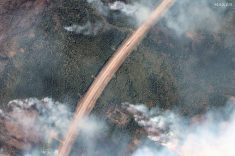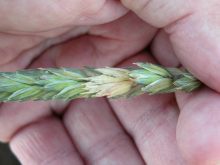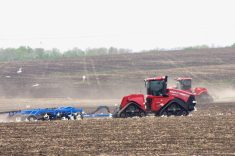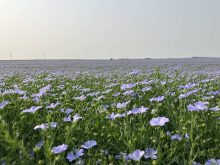Don’t get barley’s feet cold and wet — you won’t like the results.
A spate of recent wet years and the crop’s known dislike for these conditions has a research scientist from Agriculture and Agri-Food Canada looking at excess moisture and the crop.
“Barley is known to have cold feet and to be susceptible to excess moisture. With the wet weather we have had in the past years, we thought that this would be something that we should be working on,” says Dr. Ana Badea, a research scientist with the Brandon Research and Development Centre (BRDC) barley group.
Read Also

CUSMA access key among other trade noise: Seeds Canada panel
Seeds Canada conference panelists say Canada needs to stay focused and wait as U.S. trade and tariff chaos develops, and a Canada-U.S.-Mexico Agreement review looms
“We have colleagues who are looking at drought, on water and nitrogen use efficiency but this is something we have pinpointed as an issue that has not been looked at in the Canadian barley landscape.”
Badea and her colleague Bill Legge, who leads the two-row malting barley-breeding program at BRDC, have begun collecting data that will shed some light on how barley genotypes respond to waterlogging stress in Manitoba growing conditions.
“We are in the beginning of this project but we are very excited and I really think this is something that we need to look at in order to be prepared for what may be coming in future years, weather-wise,” Badea said.
Waterlogging is when excess water in the root zone affects oxygen concentration in the soil, which can impair plant growth and cause yield losses.
Waterlogging has been identified as a major issue in Manitoba’s barley production.
According to Badea, industry contacts say the majority of insurance claims from barley stems from issues with excessive water.
“For us as breeders, we need to be prepared to meet the needs of farmers. When we establish our breeding goals we look at production needs or what may be of benefit on the farm,” Badea said.
Funding for this project comes through an industry-led research and development stream that includes Alberta Barley, the Western Grain Research Foundation, the Brewing and Malting Barley Research Initiative and AAFC’s Growing Forward 2.
Funding was received in 2013 and will continue until 2018.
Worldwide screening
Researchers began by testing cultivars from colleagues around the world as well as Canadian cultivars and breeding lines from both Western and Eastern Canada.
“Our first step was to contact colleagues from across the world who are working on waterlogging,” Badea said. “I was in touch with our collaborator at the University of Tasmania and they sent us germplasm. I have also contacted researchers in Japan, who also sent us a germplasm that has tolerance to waterlogging.”
Through in-field trials, which began this season, and greenhouse testing, researchers will be analyzing collected leaf tissue to gather insight on chlorophyll concentration, fluorescence, and indicators of stress and yield impacts from a large collection of 341 two-row barley genotypes.
“We have done several tests in the greenhouse and then we have tested in different types of soil,” Badea said. “We wanted to understand how these genotypes respond. We also know that waterlogging is a complex abiotic stress and produces multiple plant responses and is complicated by many confounding factors such as temperature, plant development stage, soil type, and topography.”
Researchers are looking to identify waterlogging-tolerant genotypes that may be able to be used in the BRDC’s barley-breeding program.
“I know that is a long ways away until we will see a cultivar that will have waterlogging resistance but everything has to start from somewhere and this is an exciting beginning to where we could eventually identify a germplasm that could be used to bring waterlogging tolerance into a Canadian germplasm,” Badea said.
Aerial input
At the suggestion of Manitoba Agriculture, a partner in the project, researchers also used some aerial data collection.
BRDC researchers have partnered with Scott Chalmers, diversification specialist from the WestMan Agriculture Diversification Organization (WADO), who will use UAV technology to gather Enhanced Normalized Difference Vegetation Index (ENDVI) data and Green Normalized Difference Vegetation Index (GNDVI) data to help determine stress levels in the barley caused by excess moisture.
“It was very good to have Scott on board because we were able to better monitor our tests, collect more data in a faster and better way,” Badea said. “When collecting the chlorophyll content information, we collect that before the treatment and immediately after. You can imagine how muddy it is. Trying to collect the leaf tissue and the measurements is not an easy task. With the drone the only limitation is wind, so it is much easier to collect the data.”
Drone data has been collected beginning in mid-July until early September.
This season, researchers will also get their first chance to look at numbers related to yield.
“I am very eager to learn this fall what the yield penalty is, how much of a penalty and if that would be something acceptable, something that our farmers, from a production standpoint, would be OK with,” Badea said. “We will look at yield penalty, if there are delays or any changes in the maturity of the plants and we will try to link this data to the data that we have collected with the drone and see if there are any strong correlations.”




















